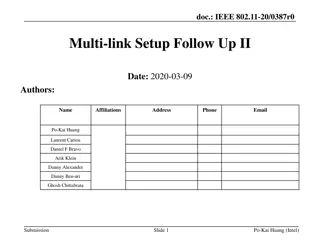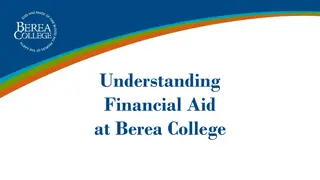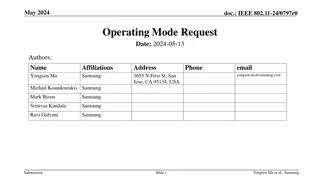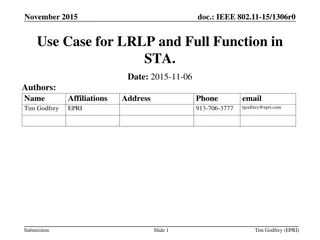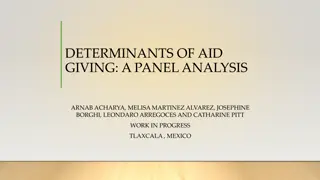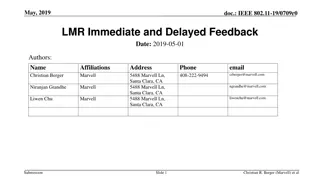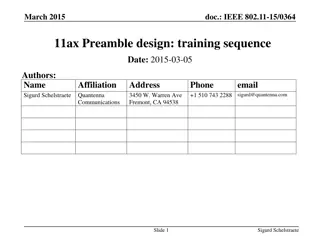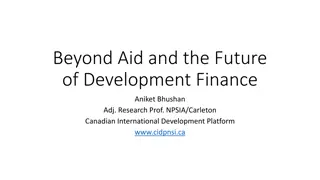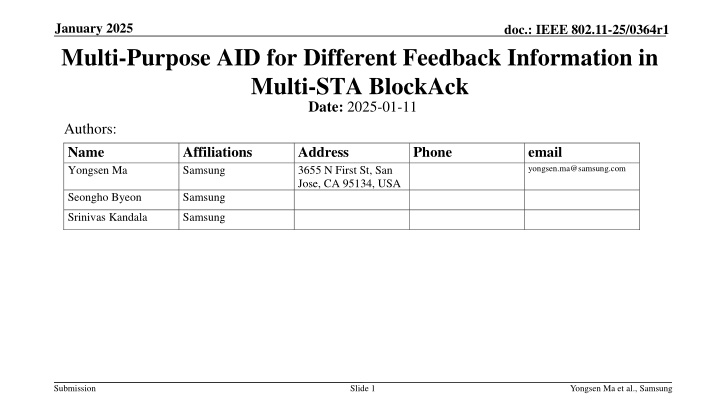
Enhancing Multi-STA BlockAck with Multi-Purpose AID
Explore the use of a multi-purpose AID value to incorporate various feedback information in Multi-STA BlockAck frames in IEEE 802.11 standards. This approach allows for improved signaling efficiency and supports multiple features simultaneously, enhancing communication accuracy and flexibility.
Download Presentation

Please find below an Image/Link to download the presentation.
The content on the website is provided AS IS for your information and personal use only. It may not be sold, licensed, or shared on other websites without obtaining consent from the author. If you encounter any issues during the download, it is possible that the publisher has removed the file from their server.
You are allowed to download the files provided on this website for personal or commercial use, subject to the condition that they are used lawfully. All files are the property of their respective owners.
The content on the website is provided AS IS for your information and personal use only. It may not be sold, licensed, or shared on other websites without obtaining consent from the author.
E N D
Presentation Transcript
January 2025 doc.: IEEE 802.11-25/0364r1 Multi-Purpose AID for Different Feedback Information in Multi-STA BlockAck Date: 2025-01-11 Authors: Name Yongsen Ma Affiliations Samsung Address 3655 N First St, San Jose, CA 95134, USA Phone email yongsen.ma@samsung.com Seongho Byeon Samsung Srinivas Kandala Samsung Submission Slide 1 Yongsen Ma et al., Samsung
January 2025 doc.: IEEE 802.11-25/0364r1 Abstract There are proposals in TGbn to use special AID values for different UHR features, e.g., Multi-STA BlockAck for unavailability report, link adaptation feedback, BSR Common Info/User Info of Trigger frame for I-FCS, MIC, DPS, DUO, ELR Proposal: a multi-purpose AID value to indicate multiple features Allow including multiple features in a single field/frame with a single AID value Example: A Multi-STA BlockAck frame contains multiple Per AID TID Info fields Each Per AID TID Info field contains the same AID11 value and different TID values (or other Control Info/Feedback Type fields) to indicate different feedback information Submission Slide 2 Yongsen Ma et al., Samsung
January 2025 doc.: IEEE 802.11-25/0364r1 Background: Feedback Context of Multi-STA BlockAck A value of 2008 in the AID11 subfield is used to identify a Per AID TID Info field that carries feedback (see 37.11.2 (Dynamic Unavailability Operation (DUO) mode)) that applies to all receiving UHR STAs. [1] If the AID11 subfield of the AID TID Info subfield is not 2045, and if the Ack Type subfield is equal to 0 and the TID subfield is equal to 13 then the Per AID TID Info subfield has the format shown in Figure 9-60a [1] Ack Type subfield equal to 0 and the TID subfield equal to 13 Submission Slide 3 Yongsen Ma et al., Samsung
January 2025 doc.: IEEE 802.11-25/0364r1 Different Feedback Information in Multi-STA BlockAck There proposals to include different information in multi-STA BlockAck, e.g., DUO BSR Link adaptation Benefits for different feedback information in the same Multi-STA BlockAck: More accurate information about the current status of the AP/STA More efficient signaling of different feedback information in a single frame Supports multiple features at the same time Submission Slide 4 Yongsen Ma et al., Samsung
January 2025 doc.: IEEE 802.11-25/0364r1 Different Feedback Information in Multi-STA BlockAck: Options Option 1: different AID values, in separate Per AID TID Info fields or in separate multi-STA BlockAck frames Option 2: same AID value, in separate Per AID TID Info fields AID11: the AID of a UHR STA for unicast, or a special value, e.g., 2008, for broadcast. Different feedback information indicated by different TID field values. Preferred option, with good balance of low complexity/overhead and high flexibility Per AID TID Info Per AID TID Info Per AID TID Info AID TID Info Feedback AID TID Info Feedback AID TID Info Feedback AID11Ack TypeTIDBlock Ack Starting Sequence Control AID11Ack TypeTIDBlock Ack Starting Sequence Control AID11Ack TypeTIDBlock Ack Starting Sequence Control Link Adaptation Info DUO Info BSR Option 3: same AID value, in the same Per AID TID Info field Differentiate by different TID field values and/or different Fragment Number field values Submission Slide 5 Yongsen Ma et al., Samsung
January 2025 doc.: IEEE 802.11-25/0364r1 Different Feedback Information in Multi-STA BlockAck: More Details on Option 2 Option 2: same AID value, in separate Per AID TID Info fields AID11: the AID of a UHR STA for unicast, or a special value, e.g., 2008, for broadcast. Different feedback information indicated by different TID values, or by other fields, e.g., Fragment Number field or new defined Control Info/Feedback Type field. Per AID TID Info Per AID TID Info Per AID TID Info AID TID Info Feedback AID TID Info Feedback AID TID Info Feedback AID11Ack TypeTIDBlock Ack Starting Sequence Control AID11Ack TypeTIDBlock Ack Starting Sequence Control AID11Ack TypeTIDBlock Ack Starting Sequence Control Link Adaptation Info DUO Info BSR Control Info/Feedback Type Control Info/Feedback Type Control Info/Feedback Type Submission Slide 6 Yongsen Ma et al., Samsung
January 2025 doc.: IEEE 802.11-25/0364r1 Conclusion This contribution presents multi-purpose AID to indicate the information of multiple features in the same frame/field. It can be used to include different feedback information in the same Multi-STA BlockAck frame. The Multi-STA BlockAck frame contains multiple Per AID TID Info fields Each Per AID TID Info field contains the same AID11 value and different TID values to indicate different feedback information Optionally may reuse existing fields (e.g., Fragment Number field) or define new Control Info/Feedback Type field to indicate different feature combinations Submission Slide 7 Yongsen Ma et al., Samsung
January 2025 doc.: IEEE 802.11-25/0364r1 References [1] IEEE P802.11bn/D0.1, January 2025 Submission Slide 8 Yongsen Ma et al., Samsung


